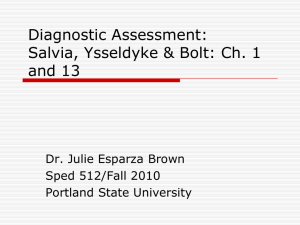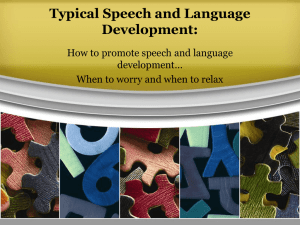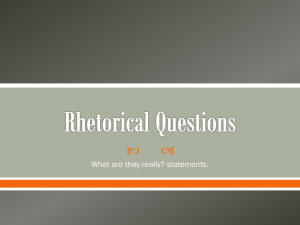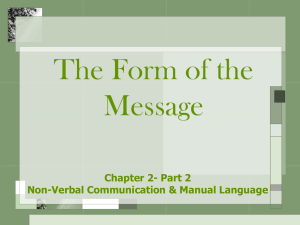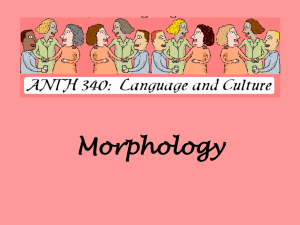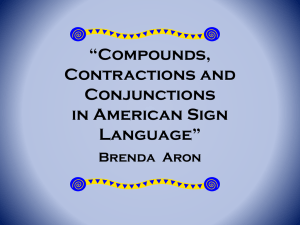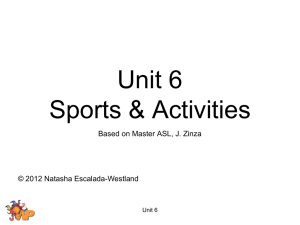ASL Linguistic Gems
advertisement
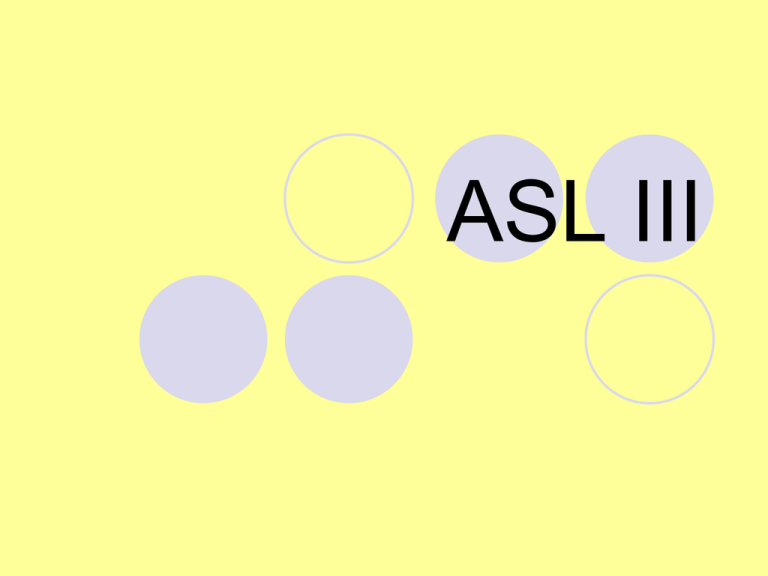
ASL III What’s the difference between… Language and Communication? ASL and Gesture? ASL and SEE Communication doesn’t need language to communicate. Language NEEDS communication in order to communicate. Communication – can be by drawing, gesture, flag, etc. Language – has symbols to govern the language for communication purpose. ASL is a TRUE language. Gesture is not a language. SEE – is not a language. It’s a method to teach deaf children English. ASL – native language used by deaf people. Sign Language Continuum American Sign Language (ASL) Signing in English Word Order Assumptions of modern languages (OSU, 1991) Writing does not exist everywhere that spoken/signed language exists. There are many communities in the world where a written form of language is not used, even in those cultures using a writing system there are individuals who fail to learn the written form of their language. (illiterate) Writing must be taught, whereas spoken/signed language is acquired automatically. Language & Culture Historical language changes English: far out, groovy, awesome, cool, sweet, gay dumb ASL: COW, HORSE, DONKEY, DEAF, SISTER/BROTHER, COMPUTER, WIFE/HUSBAND, MICROWAVE, HOME (EAT&SLEEP) _______________t _____________q ASL ITSELF TRUE LANGUAGE(wg)? ASL is not a written language, nor is there a word-for-sign correlation between ASL and English. For these reasons, this class/textbooks uses glosses to identify the meaning of signs and signed sentences. These glosses are not intended to be the only appropriate English translation, nor are they exact interpretations of signs. The glosses included in this class/textbooks are cues primarily for instructor to use in linking meaning with the sign or signed discourse. Linguistics is the scientific study of human language. http://en.wikipedia.org/wiki/Linguistics Linguistic Components Semantics Pragmatic Syntax Morphology Phonology Linguistic Components Semantics Pragmatic Syntax Morphology Phonology semantics The meanings of words and how they combine into sentence meanings. The study of MEANING. (Longman, 1992) Word or Sign may have one meaning or multiple meanings. semantics Ends Twenty-year friendship ends at altar. The show ends tomorrow. The road ends in a cul-de-sac. Run Pat ran home. (go fast by foot) The water is running. (liquid flow) There’s a run in your hose. (tear in stocking) Chris wants to run for president. (compete) Examples from Buckley (2004) semantics Pool I put five dollars in the pool. I threw a stone into the pool. Bank Ridge/side of the river Financial institution Examples from Buckley (2004) Semantics: more examples Cast - process for selecting a cast of actors. - to put a cast or a splint on the arm to keep the bones from moving. - to cast your fishing rod. Semantics: more examples File Arm Can Mean Train There is more than one correct sign or group of signs that can be used to express the meaning of an English word or words. A concept expressed in an ASL sign often cannot be conveyed by a single all-purpose English word. Likewise, English words and phrases may have variations in meaning, which require translations using different ASL signs. semantic examples Play (playing cards, act/show) Shot (tired, drink, sent, went over) Bark ( Yell, tree, dog) Semantic examples Bar (place to drink, metal rod) Jump (jumping jacks, jumping from something) Watch (watching someone, wrist watch) Space (outer space, extra space, spaced out) Stamp (post stamp, stamp on hand) semantic examples Board (at the front of a room, piece of wood, get on -plane) Bound (have your mind stuck) Bound (can’t get out of something) Star (someone famous) Star (something in the sky) Semantic examples That’s cool Be Cool Cool it off Drive my car You drive me crazy Drive by I need a break Break a leg Give us a break Semantics: With your group, come up with different ways to use the following words: - Bill Fall Cheer Lie Duck -Sink -Book -Hand -Squash -Hard -Lift -Ship -Crash - Fly -Bat -Game - Cold -Model -Tape Also…. Different sentences mean the same thing. For example: 1) John is an unmarried male. John is a bachelor. 2) The car bumped the truck. The truck was bumped by the car. 3) What do you do? What do you do for living? 4) How are you? How have you been? Howdy? Whassup? Remember…. ASL ≠ English Semantics…. MEANING. The study of ________________ Linguistic Components Semantics Pragmatic Syntax Morphology Phonology pragmatic How the interpretation and use of utterances depends on knowledge of the real world. (Longman, 1992) The effect of situation on language use. (Buckley, 2004) Meaning and context (OSU, 1991) pragmatic These sentences can all express the same request, but often indirectly. (Buckley, 2004) Please shut the window I wonder if we should shut the window. It’s cold in here. Do you feel a draft? “Ask the man upstairs.” Pragmatic: more examples Does it look like rain? It’s going to rain. Did you feel water drops? What are you doing tonight? Got any plans tonight? Anything fun going on? Can I go with you? pragmatics I need something to eat. I want to eat. I can eat a horse. pragmatics “Have you got any cash on you?” where the speaker really wants the listener to understand the meaning: “Can you lend me some money? I don't have much on me.” Pragmatics She dribbled the ball down the court and shot a basket. The birds and the bees. Keep Austin Weird pragmatic examples Do you want go out to eat dinner with me? Would you like to see a movie? It is too long of a trip to go up the stairs. I get tired every time I walk up there. Could the door be any further away? Pragmatics There’s a bear behind you! There’s a bear behind you. Run! Did you know there’s a bear behind you? What’s that bear doing in here? Pragmatics & Semantics Semantics focuses on the meaning depending on the context (pragmatics)… Linguistic Components Semantics Pragmatic Syntax Morphology Phonology Syntax How words are organized into sentences. The study of how words combine to form a sentence and the rules which govern the formation of sentences. (Longman, 1992) Syntax English basic word order is Subject+Verb+Object (“SVO”). Kim ate oranges. ASL basic word order is Subject/Object+Verb (“SOV” or ”OSV”) ORANGE KIM EAT-FINISH KIM ORANGE SHE EAT-FINISH **Basic** ASL Grammar Order 1) TIME Reference (not duration or tense) 2) TOPIC a) Direct Object i) assign reference point, if necessary ii) adjectives for direct object b) Subject i) assign reference point, if necessary ii) adjectives for subject 3) COMMENT a) Reference point for Object and Subject b) Verbs i) Adverbs are implied in nonmanual signals i) Verb aspects iii) Helping/conditional verbs come after the main “action” verb. 4) WH-Q YES/NO-Q Negation/Assertion Tense (If Time Reference not included. It would be redundant.) Source: Amanda Noark Revised by Lisa Gelineau Syntax Example: English – I have to buy the book. S O conditional verb main verb (CV) (MV) ASL - BOOK O ME BUY HAVE-TO[AF-FO] S MV CV Syntax More examples: I went to a grocery store yesterday. Did he buy the toaster? She will buy a car. Linguistic Components Semantics Pragmatic Syntax Morphology Phonology Morphology - the study of smallest meaningful unit in a language. - how new words are created from smaller pieces. (Buckley, 2004) Morphology Basic Concept Numeral Incorporation Verb-Noun pairs Compounds Temporal Aspect Reduplication Subject-Object Agreement Morphemes Classifiers And many more… Morphology: Basic Concept - everyday vocabulary HOUSE, BOAT, SHOES, CANDY, BOOK, CHAIR, BOY Morphology: Numeral Incorporation – signs with numbers in it 4-MINUTES, 2-WEEKS, 4-MONTHS, 2-YEARS, THREE-O’CLOCK Morphology: Noun-Verb Pairs English: ASL: Noun cónvict ségment prótest Verb convíct segmént protést AIRPLANE CHAIR BOOK CLOTHES NEWSPAPER FLY-TO SIT OPEN-BOOK PUT-ON-CLOTHES PRINT Morphology: Noun-Verb Pairs Differences: English:1) placement of stress 2) stress influences vowel ASL: 1) frequency (single or repeated) 2) directionality 3) manner (continuous or hold) Morphology: Compounds English: Hatrack Blackboard Homework Greenhouse ASL: RED^HAIR TRUE^WORK FACE^STRONG FEEL^LIKE Morphology: Compounds Two signs joined to become a new sign. The movement of each sign is reduced to one time each. Ex: SLEEP + CLOTHES 1x 1x EAT + MORNING 1x 0x Some signs have historical changes. Ex: BIRD = BEAK + WINGS Now = BEAK SPRING = SUMMER + GROW Now = GROW++ Some signs have fluidity principle: formerly two different handshapes, now two similar handshapes. Ex: HUSBAND SISTER Morphology: Compounds English ASL (GLOSS) Breakfast Grocery Accidentally, by chance, fate Gold Buy Just as if, it’s like, for example Closely resemble, bears a strong resemblance to Look like, resemble Money in reserve To talk about, mention Parents Siblings EAT+MORNING FOOD+BUY WRONG+HAPPEN EARRING+YELLOW MONEY+GIVE-TO THINK+SAME-AS FACE+STRONG FACE+SAME-AS MONEY+BEHIND TALK+NAME MOTHER+FATHER SISTER+BROTHER Morphology: Morpheme 1) Unladylike The word unladylike consists of three morphemes. Morpheme breaks: a) un- 'not' b) lady '(well behaved) female adult human' c) like 'having the characteristics of‘ None of these morphemes can be broken up any more without losing all sense of meaning. Lady cannot be broken up into "la" and "dy," even though "la" and "dy" are separate syllables. Note that each syllable has no meaning on its own. Morphemes: More Examples in English 2) Dogs The word dogs consists of two morphemes. Morpheme breaks: a) dog, and b) -s, a plural marker on nouns Morphemes: More Examples in English 3) Technique The word technique consists of only one morpheme. Even though the word has two syllables, it is a single morpheme because it cannot be broken down into smaller meaningful parts. (Buckley, 2004) Morphemes: Examples in ASL 1) 600 (six hundred) The sign 600 consists of two morphemes. Morpheme breaks: a) 6 – 'a number' b) CL: C - 'hundred‘ (handshape classifier) Morphemes: More Examples in ASL 2) PUDDLE The sign PUDDLE consists of two morphemes. Morpheme breaks: a) WATER b) CL: bend-L bend-L Morphemes: More Examples in ASL 3) BASEBALL The sign BASEBALL consists of only one morpheme. Linguistic Components Semantics Pragmatic Syntax Morphology Phonology Phonology The study of the smallest sounds or units in a language. The use and patterning of sounds/signs in language. (Buckley, 2004) distinctive sound/sign units of a language (Longman, 1992) Phonology Spoken Language – 3 parameters 1) Place of articulation (where) 2) Manner of articulation (how) 3) VOICING ( + OR -) a) Voiceless: s, f, p, k b) Voiced: z, v, b, g Phonology English examples: pat pad dog dogs cónvict (n) convíct (v) Phonology Sign Language – 5 parameters 1) Handshape 2) Location 3) Movement 4) Palm Orientation 5) Non-manual Signals Phonology ASL examples: SOUR PRINT APPLE DEFINE HOME MAYBE WHY? PRETTY Location BORING NEWSPAPER Movement Location ONION Movement DELAY Handshape YESTERDAY Palm Orientation BALANCE BECAUSE Non-Manual Signals GORGEOUS Non-Manual Signals Sources Structure of ASL lecture notes - Byron Bridges University of Pennsylvania, Introduction to Linguistics lecture notes online Gene Buckley B. Bridges & M. Metzger.(1996) Deaf Tend Your. Silver Spring, MD: Calliope Press. B. Bridges & K. Cagle. The Fifth Parameter: Non-Manual Signals. (videotape/DVD - soon to be released) C. Lucas & C. Valli. (1995, 2nd ed.) Linguistics of American Sign Language: An Introduction. Washington, D.C.: Gallaudet University Press. SLNG 1445 course lecture notes at Austin Community College by Byron Bridges, Nathie Marbury, and Lisa Gelineau. OSU (1991) Language Files, 5th edition. Dept of linguistic at Ohio State University. www.wikipedia.com www.dictionary.com Read/Convey Multiple Meaning Signs Understand ASL Concepts Word Choice: Ability to Convey Conceptual Signs Sign Vocabulary: Accuracy, Clarity Develop Sense of Whole Message
